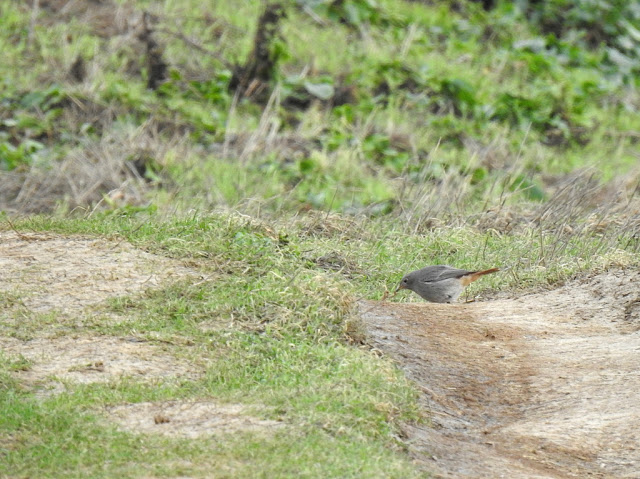Well, the chill came. Sort of. And as I sat down at the laptop earlier, it was actually snowing . Big, fat, wet flakes. The first we've had for about four years I think. It even settled...

|
|
Rare Bridport snow in progress. |
Bird-wise I can't say a lot happened. Early-morning visits to West Bay have not produced Golden Plover, nor any interesting ducks. By far the best bird was a Purple Sandpiper back on the harbour wall first thing yesterday, which by the afternoon had become two...

|
|
Two Purple Sandpipers. Little beauties! |

|
| Bird 1 |

|
| Bird 2 |

|
|
Purple Sanderling |
I did visit the spot where I flushed two Woodcock during the mid-December freeze, and put a single bird up. Unfortunately it flew out the far side of the thicket, and I failed to see it. Can I count a loud clattering of wings?
Yesterday I walked the cliff-top coast path which runs alongside the local golf course. A good count of 11 Skylarks on the golf course, and a female-type Black Redstart in exactly the same spot as last time I walked this path, a few weeks ago...

|
|
Black Redstart in the act of despatching some small, wriggly
thing. |

|
|
I get an awful lot of Black Redstart photos like this. |
So, that happened yesterday.
And this happened today...

|
|
That massive rock-fall includes a hefty chunk of clifftop! |
I am one of those risk-averse types who keeps well away from cliff edges, but I wonder how close to the path that fall got? And on the rare occasions I have walked the beach there, it has always been at low tide and close to the water's edge. You would not believe how many folk you see blithely strolling along at the foot of those cliffs. And in the summer, whole families set up for the day on that beach. Mad! And it's not like there are no warning signs.
In the case of this particular fall, close to the water's edge would not have been far enough away...

|
|
A couple of people circled to give it some scale. |
This afternoon I headed up the valley towards Mangerton - part of my
Bridport North patch - and was surprised to see a small flock of
Cormorants fly over. Ones and twos are not unusual, but there were nine.
They circled a couple of times, before dropping in to some riverside trees. Five
were perched up in full view, and they reminded me of what is a fairly typical
sight on big, inland gravel pits - arboreal Cormorants. In the home
counties I would expect such gatherings to include many (mainly?)
'Continental' Cormorants (P. c. sinensis), but here? Three miles from the Dorset coast?
On the Axe at Seaton, and locally in West Dorset, I have checked countless Cormorants for possible sinensis birds. I've had a few reasonable candidates, including one or two probables that I couldn't be bothered to follow through on, but most birds have been unequivocally nominate birds, i.e., P. c. carbo. Sinensis seems to be genuinely rare, at least on the coast. Still, nothing ventured...
So I took some photos...

|
|
To my eyes, this bird is spot on for sinensis. |
Re the caption above: how can I say that?
It's all down to the gular pouch angle. Thus...

|
|
This is dead easy to measure in the field. All you need is a protractor.
And a tranquilliser gun. |
There is a 2004 paper on this topic (which is where I got those figures) and you can find a link to it HERE. There is a very good article in the Devon Birds journal too, but I cannot remember which issue and no longer have a copy. Basically, any Cormorant with a gular pouch angle pushing 90 degrees (or greater) is definitely going to be sinensis*. The only proviso is that your bird needs to be in perfect profile. I took photos of all five, and these are as close as I got to the requisite side-on shot...

|
|
Apart from the youngster, I would say there isn't much argument. The
protractor has spoken. |
The young bird is probably border-line, but I'll bet it is
sinensis too. In fact I would not be surprised if all nine were.
I have no idea what the Dorset status of this subspecies is, because sinensis is not even mentioned in any of the four most recent Dorset Bird Reports (2018-2021 - the only reports I have) and gets very sketchy treatment in The Birds of Dorset (2004), the county avifauna.
So there you go. Cormorants. Common birds, but - if you can be bothered - entertainment a-plenty.
* This is a bit simplistic, but will do for me.
No comments:
Post a Comment